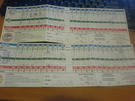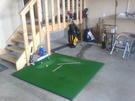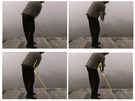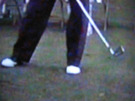“Why is a pivot driven lever assembly missing from TGM?
I'm all ears..”
Ben Doyle, is all about the Pivot. How many times have you heard him say “Load it, store it, Shoot it”? He doesn’t say “Load it, Store it, then whack it with your hands”. Have you asked him what “Shoot it” means? He’ll say, “shoot the Primary Lever with the PIVOT”.
Ben Doyle produced a DVD describing the 24 components. More than 50% of this DVD is about the Pivot. No matter what he says about the 24 components he never fails to relate each of them to the Pivot, as I recollect.
Written across Ben’s forehead is “Never move the Club with your Hands. The Hands are moved by the Pivot.”
The Pivot will deliver the Hands to Release, then Shoot the Primary Lever though Impact. Hip Action. Load the Feet. Load the Feet, Load the Feet, Load the Feet.
TGM is about the hands sensing, directing and applying Pivot Forces.
How many times have you heard and read that Zone #3 can only be as good as Zone #1.
Does that answer your question?
Allow me to give you and example before you read 7-12.
In one paragraph, Homer says – (the Pivot) “is the massive vehicle which transports the Power Package Assembly to the launching pad” and Second, it then becomes “the massive rotor, supplying Angular Momentum for the Throw Out power transfer to the Swinger's orbiting Left Arm.
Homer is describing a sequenced pivot for a Straight Line Delivery Path. Sit-down, then Hip action. Ben’s “Shoot the Lever”.
This is a two Stage Pivot that you asked about in the previous post. It’s basic TGM.
Please review the following:
“7-12 PIVOT The Pivot is the utilization of multiple centers to produce a circular motion for generating Clubhead Force on an adjustable Plane. Plus the maintenance of balance throughout the weight shifts that accompany the turning and bending of the necessary for the two Line Delivery Paths. A Pivot is on superficially correct that fails to maintain alignments or allows the player to get ĺ─˙out of position”.
It is the massive vehicle which transports the Power Package Assembly to the launching pad and back-up support for the Hitters driving Right Arm (6-B-1). It is the massive rotor, supplying Angular Momentum for the Throw Out power transfer to the Swinger's orbiting Left Arm (6-B-3).
It is the sequencing and spacing of Zone #1 Stroke Components. It consists of – as separate and distinct elements – the motions and actions of the Shoulders, Hips, Knees and Feet. The term Pivot is relative in that it can be classified as anything between Full motion and Zero motion and may include all, part or none of the possible Component Motions and actions. It defines their participation (6-M-1) including the requirements of Plane Angle and Stance Line Variations (10-12, 10-15-0). It is Zone #1, the first and foundational of the three Zones in Chapter 9. Study 2-0, 9-0 and items 1 and 2 under Sketch 1-L.
As Stroke Component, the term PIVOT refers only to the degree and direction of its own motion as the framework or pattern within which all the Pivot Components must be arranged and adjusted. The relative participation of the individual Pivot Components is always determined under their own Pattern references. ALL motion – Pivot and Power Package – moves parallel to the selected Delivery Line. That is, prior to the Downstroke Turn, a Slide parallel with either the Angle of Approach or the Plane line per 2-J-3.”
Do you see in the last paragraph above where homer says: “The relative participation of the individual Pivot Components is always determined under their own Pattern references.”
That means that you should feel free to design your own Pivot for your Stoke Pattern but that each component should be designed within their component variations in chapter 10. Homer is saying that you should do it because nobody else is going to do it for you.
There are different types of Pivots. There are Pivots for Circle Path deliveries as well as Pivots for Straight Line Delivery Paths. They can be as delicate as needed for a three foot chip shot or as Violently Powerful as needed for a 300 yard Drive. Or Zero. Players option to fit the Stoke needed at hand.
Use the Components in TGM to design your own Pivot. Create five or six or as many as you can remember. But keep in mind, the Pivot moves the Primary Lever.
Lagpressure,
You’re an accomplished Golfer, knowledgeable in TGM and you’ve studied with Ben Doyle and Moe. You should be designing pivots but you choose to use your arms and hands in the pursuit of distance. You can’t have it both ways. So, you’ve found a Pivot technique that can drive the swing and align the hands through Impact. That’s simply a Pivot Controlled Hands Procedure. Nothing wrong with that.
Hey, if you have any more questions, just ask.
The Secret to Golf is producing a constant rate of acceleration of the Primary Lever Assembly.














